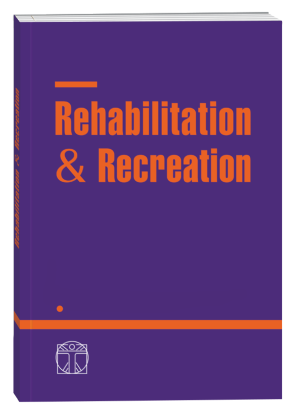UWARUNKOWANIA AKTYWNOŚĆI FIZYCZNEJ
DOI:
https://doi.org/10.32782/2522-1795.2023.14.30Ключові слова:
sport, kultura fizyczna, sprawność fizyczna, wychowanie fizyczne.Анотація
The most important factors that have a significant impact on health and life expectancy are physical activity. Physical activity is one of the main components of a healthy lifestyle. There is a common belief that physical activity is one of the most important categories that determine the proper functioning of the human body. Leading an active lifestyle has many benefits. The benefits of physical activity are obvious. Systematic physical activity is a very strong biological stimulator and is one of the main determinants of human physical and mental health. Its optimal level stimulates development, secures motor needs, strengthens the heart efficiency, improves the flexibility of muscles and joints, and strengthens muscles and bones. Therefore, specific forms of physical activity include not only sports exercises, but also physical effort related to active movement, e.g. to work, school, work, doing all kinds of housework and physical activity in free time). Physical activity is, of course, associated with a very differentiated energy expenditure, depending on the intensity of exercise / physical effort, its duration, ambient temperature or body weight of the person performing the physical effort. It has been proven that active people, compared to inactive people, feel better and experience less mental or physical ailments, such as low mood or headaches. Physical activity, as commonly perceived, is associated with intensive practicing of various sports. Meanwhile, you don't need to be a seasoned runner or an excellent swimmer to achieve the level of physical activity that will positively affect our health. Bearing in mind the above conditions, an attempt was made to diagnose this phenomenon, focusing mainly on school students. They wanted to find out what level of knowledge in terms of physical activity and its impact on health is represented by students, and what lifestyle they lead themselves.
Посилання
Cendrowski A. (1997). Przewodzić innym. Poradnik dla liderów zdrowia i sportu. Agencja Promo-Lider. Warszawa.
Czarnecki D., Skalski D. W., Kowalski D., Vynogradskyi B., Grygus I. (2022). Aktywność fizyczna seniorów warunkiem zdrowia i dobrej jakości życia. Rehabilitation & recreation. 12. 105–112. https://doi.org/10.32782/2522-1795.2 022.12.15
Diachenko-Bohun M., Hrytsai N., Grynova M., Grygus I., Skaliy A., Hagner-Derengowska M., Napierała M., Muszkieta R., Zukow W. (2020). Historical Retrospective of the Development of Scientific Approaches to Health- Saving Activity in Society. International Journal of Applied Exercise Physiology, 9(1), 31–38. http://www.ijaep.com/index.php/IJAE/article/ view/692
Diachenko-Bohun M., Rybalko L., Grygus I., Zukow W. (2019). Health Preserving Educational Environment in the Condition for Information Technologies. Journal of History Culture and Art Research. 8(2), 93–101. doi:http://dx.doi. org/10.7596/taksad.v8i2.2075
Diachenko-Bohun, M., Hrytsai, N., Grynova, M., Grygus, I., Muszkieta, R., Napierała, M., Zukow, W. (2019). Characteristics of Healthbreakers in the Conditions of Realization of Health-Safety Technologies in Education Structures. International Journal of Applied Exercise Physiology, 8(3.1), 1–8.
Drabik J. (1997). Promocja aktywności fizycznej (wprowadzenie do problematyki), cz. III. Gdańsk.
Drabik J. (2011). Profilaktyka zdrowia – aktywność fizyczna czy aktywność ruchowa. Wychowanie fizyczne i zdrowotne.
Grygus, I., Chovpylo, M., Ortenburger, D. (2018). Role of Physical Activity in the Process of Physical Rehabilitation of Pregnancy. Physical Education, Sports and Health Culture in Modern Society. (2(42), 102–110. https://doi.org/ 10.29038/2220-7481-2018-02-102-110
Hrytsai N., Trokhymchuk I., Diachenko- Bohun M., Grygus I., Muszkieta R., Napierała M., Hagner-Derengowska M., Ostrowska M., Smoleńska O., Zukow W. (2020). The Formation of System of Knowledge about Oncology Diseases and Their Prevention of Future Biologists. International Journal of Applied Exercise Physiology. 9 (4): 6–11. http://www. ijaep.com/index.php/IJAE/issue/view/30
Jodkowska M. (2013). Aktywność fizyczna i jej uwarunkowania. Aktywność fizyczna młodzieży szkolnej w wieku 9–17 lat aktualne wskaźniki, tendencje ich zmian oraz wybrane zewnętrzne i wewnętrzne uwarunkowania. Raport końcowy. Warszawa.
Kwilecki K. (2011). Rozważania o czasie wolnym. Wybrane zagadnienia. GWSH, Katowice.
Lavrin G.Z., Sereda I.O., Kuczer T.V., Grygus I.M., Zukow W. (2019). The Results of Student’s Survey on Models of Physical Education in Universities and Motivations to Encourage for Active Participation in Physical Education. International Journal of Applied Exercise Physiology. VOL. 8 (2). 140–143.
Maltsev D., Andrieieva O., Kashuba V., Yarmak O., Dobrodub E., Grygus I., Prusik K. (2022). Assessment of the Quality of Active Family Leisure. Physical Education Theory and Methodology. 22(3), 386–392. https://doi. org/10.17309/tmfv.2022.3.13
Momot O., Diachenko-Bohun M., Hrytsai N., Grygus I., Stankiewicz B., Skaliy A., Hagner-Derengowska M., Napierala M., Muszkieta R., Ostrowska M., Zukow W. (2020). Creation of a Healthcare Environment at a Higher Educational Institution. Journal of Physical Education and Sport, Vol 20 (Supplement issue 2), 975–981.
Owczarek S. (red.) (2009). Ruch w terapii otyłości. Towarzystwo Krzewienia Kultury Fizycznej. Warszawa.
Petruk L., Grygus I. (2019). The influence of physical exercises on physical development and physical preparedness of the first year female students. Sport i Turystyka. Środkowoeuropejskie Czasopismo Naukowe, 2, 3, 97–105.
Psaltopoulou T., Kyrozis A., Stathopoulos P. et all. (2008). Diet, physical activity and cognitive impairment among elders: the EPICGreece cohort (European Prospective Investigation into Cancer and Nutrition). Public Health Nutr.
Savliuk S., Kashuba V., Romanova V., Afanasiev S., Goncharova N., Grygus I., Gotowski R., Vypasniak I., Panchuk A. (2020). Implementation of the Algorithm for Corrective and Preventive Measures in the Process of Adaptive Physical Education of Pupils with Special Needs. Teorìâ Ta Metodika Fìzičnogo Vihovannâ, 20(1), 4–11. https://doi.org/10.17309/tmfv.2020.1.01
Skalski D., Lizakowski P., Nesterchuk N., Grygus I. (2018). Klasowe i warstwowe uwarunkowania uczestnictwa w sporcie a edukacja zdrowotna. Rehabilitation & recreation. 3. 132–138.
Wolańska T. (1995). Aktywność fizyczna a zdrowie. Biblioteka Polskiego Towarzystwa Naukowego Kultury Fizycznej. Tom III. Warszawa.
Zabolotna O., Skalski D., Formela M., Kowalski D., Nesterchuk N., Grygus I. (2019). Rodzina a kultura fizyczna. Socjologiczne aspekty rodziny w kontekście edukacji zdrowotnej. Rehabilitation & recreation. 4. 37–48. http://doi.org/10.5281/zenodo.3383723
Zabolotna O., Skalski D., Formela M., Nesterchuk N., Grygus I. (2019). Physical education as a process of learning physical culture and implementation in health education. Rehabilitation & recreation. 4. 56–61. http://doi. org/10.5281/zenodo.3383741
Zabolotna O., Skalski D., Nesterchuk N., Grygus I. (2019). Health-related good of physical culture and health education. Rehabilitation & recreation. 5. 53–58. http://doi.org/10.5281/ zenodo.3383741
##submission.downloads##
Опубліковано
Як цитувати
Номер
Розділ
Ліцензія

Ця робота ліцензується відповідно до Creative Commons Attribution-NonCommercial-NoDerivatives 4.0 International License.











